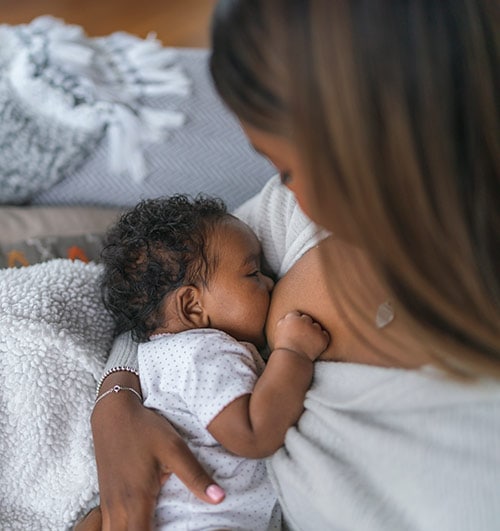Newborn Breastfeeding Basics
Many people have questions about breastfeeding and want to make sure their baby is getting enough breast milk in the first couple of weeks. Here are a few common questions and answers about breastfeeding newborns.
How do I know if my baby is getting enough to eat?
See CDC’s page How Much and How Often to Breastfeed for more information on breastfeeding during the baby’s first days, weeks, and months of life.
Many mothers worry about whether they can make enough milk for their baby. These signs can help you to know that your baby is getting enough:
- Your baby is breastfeeding often, 8-12 times per day (24 hours).
- You can see and hear your baby swallowing while breastfeeding.
- Your baby seems content after a feeding.
- Your baby is steadily gaining weight. It is normal for breastfed babies to lose some weight in the first week following birth, but they should be back to their birth weight by day 10-14 of life.
- Your baby has enough pees and poops throughout the day.
Baby poop can vary in color. In the first week, baby poop changes from black or dark green to a yellow color.
| Age of Baby | Minimum # of Wet Diapers | Minimum # of Poops |
|---|---|---|
| Day 1 | 1 | 1 |
| Day 2 | 2 | 3 |
| Day 3 | 5 | 3 |
| Day 4 | 6 | 3 |
| Day 5 – Day 7 | 6 | 3 |
Table adapted from: How Much Milk Your Baby Needs | WIC Breastfeeding Support. Homepage | WIC Breastfeeding Support. (n.d.). Retrieved from https://wicbreastfeeding.fns.usda.gov/how-much-milk-your-baby-needs.
After the first week, poop from babies who have received only breast milk will be yellow and can look seedy. After the first week up to about 6 weeks, your baby might have 6 or more poops a day (24 hours). After about 6 weeks, your baby may have fewer poops each day.
Signs that your baby might not be getting enough to eat are:
- Your baby is breastfeeding fewer than 8 times per day (24 hours) most days.
- You cannot see or hear your baby swallowing while breastfeeding.
- Your baby has trouble staying latched on the breast or you hear clicking sounds during feedings.
- Your baby seems fussy after breastfeeding.
- Your baby continues to lose weight after day 5.
- Your baby has fewer than 3 poops and fewer than 6 pees per day by 5 days old.
- Your baby’s skin looks a bit yellow.
If you have any questions or concerns about your baby’s health or if you are worried that your baby is not getting enough to eat, speak to your baby’s healthcare provider right away.
Am I breastfeeding correctly?
For more information on what to expect while breastfeeding, visit CDC’s What to Expect While Breastfeeding.
Breastfeeding is a learning process. Each baby and mother’s experience with breastfeeding is different. It is important that your baby has a good latch. This helps your baby get enough breast milk. Below are signs of a good or bad latch.
Signs of a good latch

- Your baby’s mouth is open wide over the areola (the darker colored area around your nipple), with lips turned out.
- Your baby’s chin is resting against the breast, baby’s chest and stomach are against your body, baby’s head is straight and not turned to the side.
- You can see and hear your baby swallowing while breastfeeding.
- Your baby is swallowing regularly.
Signs of a bad latch
- Your baby is only suckling on the nipple.
- Your baby’s lips are curled inward.
- Breastfeeding hurts.
- Your nipples are cracked or bleeding.
- Your nipples look flat or misshapen after breastfeeding.
- Your baby keeps coming off the breast while breastfeeding.
How do I build a full milk supply?
- Make sure your baby has a good latch.
- Breastfeed often in the first few weeks. Your baby may want to eat as often as every 1 to 3 hours, including during the night.
- If you are not breastfeeding at the breast, express or pump your breast milk as often as your baby normally eats.
- Breastfeeding, or expressing or pumping breast milk, sends a signal to your breasts to keep making milk.
Breastfeeding help is available. If you see signs of a bad latch or are worried about your milk supply, get help from a healthcare or lactation support provider as soon as you can.
